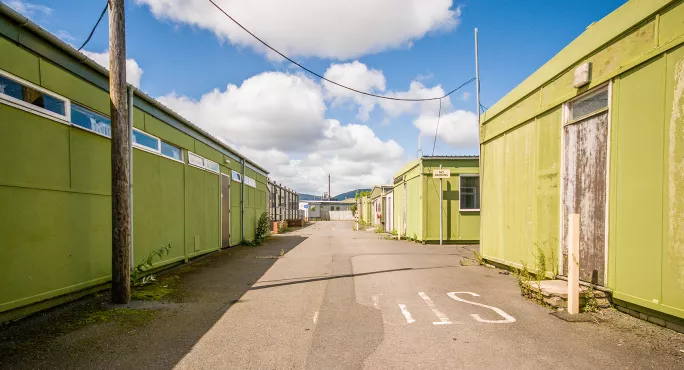DfE: ‘Blend’ temporary buildings into surroundings

Temporary buildings for schools affected by reinforced autoclaved aerated concrete (RAAC) should “blend” into their surroundings as much as possible and be installed away from playing fields, the Department for Education has told schools.
The DfE has this morning published best practice guidelines for schools having to install temporary buildings due to RAAC on their site.
The guidance sets out how schools should install temporary buildings according to class CB of the Town and Country Planning Order 2015, a right which allows the installation of the buildings without applying for planning permissions.
Under this right, when installing temporary buildings, schools are expected to try and minimise the visual impact of the buildings, even if they will only be in place for a limited period.
- 214 schools now confirmed by DfE to have RAAC
- ‘No clear timeline’ for end of RAAC crisis in schools
- RAAC concrete in schools: everything you need to know
“Temporary buildings that blend reasonably well into their surroundings, due to careful consideration of size and colour schemes, will have less visual impact in the landscape and may be more acceptable to local communities,” the guidance says.
Here are six more things that RAAC-affected schools need to know about installing temporary buildings:
1. Temporary buildings must be removed once RAAC is remediated
The guidance also states that temporary buildings installed under this right “must be removed once RAAC-affected buildings on the school site have been remediated or replaced, or before the right expires on 24 October 2026, whichever comes first”.
2. Temporary buildings cannot be placed off the school site
According to the guidance, schools cannot erect temporary buildings off-site, or use them in any way to increase the school’s published admission number.
The guidance says: “Due to the impact additional pupils and associated vehicle trips would have on the local road network and space for parking and drop-off or pick-up, class CB only allows temporary buildings to be installed on the same school site that has RAAC-affected buildings.
“It does not permit development which would result in an increase to the school’s published admission number.”
This means they cannot be placed on separate school sites, such as a satellite site for the school, or another school within the same multi-academy trust.
3. Temporary buildings must not be higher than nine metres
Temporary buildings cannot be higher than nine metres or two storeys, or exceed a combined floor space of 125 per cent of the buildings vacated due to RAAC.
4. Schools should avoid placing temporary buildings on land needed for PE
Schools are also expected to consider the impact of where they place the temporary buildings.
The guidance says: “It is important that schools continue to meet their curriculum requirements for physical education and sport, so schools should aim to avoid putting temporary buildings on land which is used to deliver the PE curriculum, such as sports pitches (including the maintenance of adequate safety margins) and playgrounds.”
If schools must place temporary buildings on playing fields, they are advised to find offsite areas to deliver the PE curriculum. The DfE has already promised to foot the revenue costs of renting alternative spaces like this, as well as travel costs.
5. Schools should try not to block parking spaces or paths
Schools are also told to try not to place the temporary buildings so they reduce parking or turning space, or cut off footpaths and cycle paths.
It added that if the temporary buildings alter access to the school, they may require planning permission.
6. Consider the environmental impact of temporary buildings
Finally, the guidance says the environmental impact of temporary buildings should be considered, such as their impact on trees and soil.
Schools should also monitor whether the land buildings are placed on is contaminated or at risk of flood.
You need a Tes subscription to read this article
Subscribe now to read this article and get other subscriber-only content:
- Unlimited access to all Tes magazine content
- Exclusive subscriber-only stories
- Award-winning email newsletters
Already a subscriber? Log in
You need a subscription to read this article
Subscribe now to read this article and get other subscriber-only content, including:
- Unlimited access to all Tes magazine content
- Exclusive subscriber-only stories
- Award-winning email newsletters



